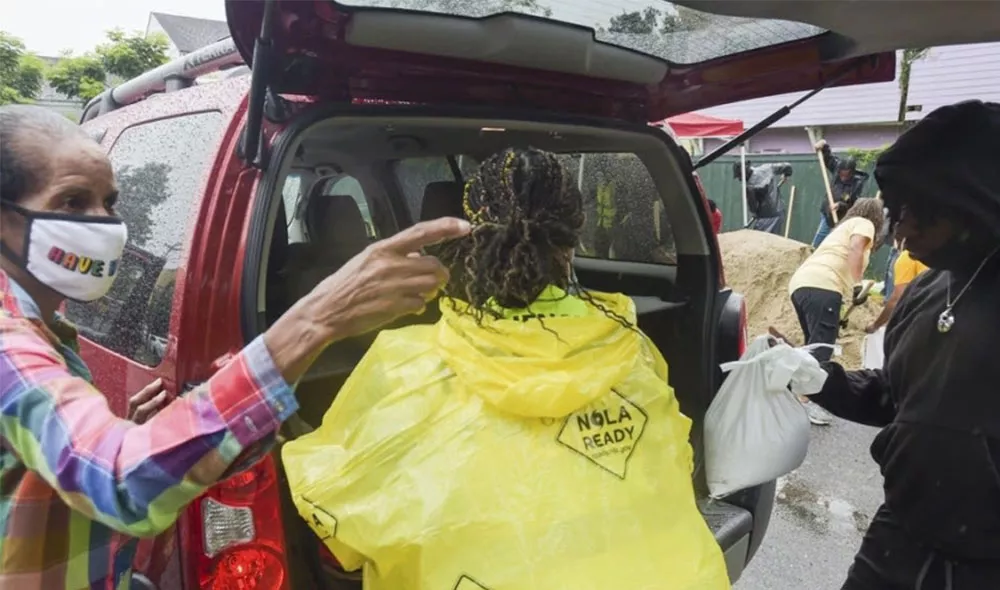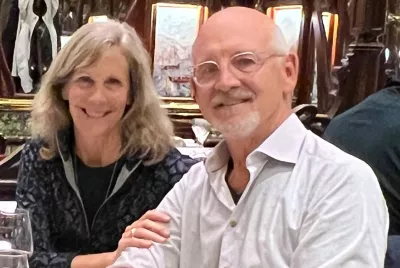From Katrina to Today: Our Unshakable Commitment

August 29, 2005
The forecast had shifted, but in New Orleans that didn’t always mean much. Clinton Charlot and his wife packed for just a few days, locked up their home, and headed to Covenant House, where he served as finance director, to begin the caravan to safety ahead of Hurricane Katrina.
“We thought we’d be gone for the weekend,” Clinton remembers. “I left my car behind. We took the old car, picked up my mother and mother-in-law, loaded one of the youth in with us, and joined the staff and vans headed for Texas. We had sandwiches, water, a caravan of vans and staff cars. Some staff stayed behind, but those of us on the road… we thought we’d be back in a couple of days.”
The drive that normally took five hours stretched into eighteen before they finally reached Covenant House Texas. There, they temporarily settled into the Rights of Passage building, sharing the space with youth who were already in Houston’s program. Within days, the news came: five feet of water in parts of New Orleans, neighborhoods swallowed whole, homes, including Clinton’s, gone. “It was a sick feeling,” he says. “That was when we knew we couldn’t go home.”
Hurricane Katrina was among the fiercest storms to ever strike the United States, and it remains the costliest. At least 1,000 people in Louisiana alone are known to have lost their lives, and the storm caused more than $200 billion in damage across Louisiana, Mississippi, the Florida panhandle, Georgia, and Alabama.
Life Uprooted
Clinton and his wife were just two years away from paying off their mortgage. Their 2,700-square-foot home was filled with memories, and his prized bamboo and palm garden. Katrina took it all.
“We were as homeless as the kids, just in a different way.”
Instead of returning to rebuild, they bought a 700-square-foot condo, where they lived for nearly 20 years. Clinton retired from Covenant House in July 2022, staying on an extra six months to help train his successor. Just last month, he and his wife moved again, this time into a slightly larger condo, joking that it was finally time to “get off the third floor because we’re getting old.”
Covenant House as Lifeline
While the New Orleans campus became a hub for other agencies — Tulane Hospital set up a clinic there, the U.S. Marshals used the space — Clinton was living alongside our resident youth in Texas. Some were from New Orleans, others from Houston, and blending the two groups came with its challenges.
“There were two boys who were a handful before Katrina,” he says. “In Texas, they became protectors, keeping the peace, telling the Houston kids, ‘Don’t mess with Mr. Charlot.’”
Just days after the initial devastation of Hurricane Katrina, Hurricane Rita brought wind, rain, and more flooding to Houston. The New Orleans evacuees, both youth and staff, were forced to uproot again, this time with Covenant House Texas youth and staff.
When the group was relocated to Columbus, Texas, the setting brought its own surprises, like snakes near the pool. “We killed them, grilled them, and ate them,” Clinton laughs. “I couldn’t tell you what kind they were.”
Finance Director Turned Direct Care Provider
Back home, Clinton didn’t handle cash directly. Policy required separation of duties. But in Texas, he was the only finance person who evacuated with the youth, and his responsibilities shifted overnight.
“I had all the petty cash, all the youth savings accounts. If they needed something, I was the one they came to. I’d never had that level of daily interaction with them before. We lived together, ate together. We were all figuring it out as we went.”
He also coordinated payroll for scattered CHNO staff, opening a new bank account in Texas to keep everyone paid. “It was a challenge, but it was what had to be done.”
Lessons That Changed the Federation
From Clinton’s perspective, Katrina taught Covenant House three critical lessons:
Advance Planning Matters: Sites need to coordinate evacuation routes, transportation, and shelter plans long before a storm forms.
Reliable Vehicles Save Lives: “Our vans made it, but they were in bad shape by the time we got back. We can’t risk that again.”
Family Reunification Is Key: In disasters, keeping youth close to their families whenever possible reduces trauma.
These lessons now echo in Covenant House’s emergency response protocols. As Leslie McGuire, cChief pProgram oOfficer for Covenant House International, notes: “Evacuation plans and plans for food, water, and medication supplies are non-negotiable. Katrina made that clear.”
Two Faces of the Aftermath
Years later, Clinton ran into those two “challenging” boys from Texas. One had gone to trade school, built a career, and was thriving. The other was still on the streets.
“That stuck with me,” Clinton says quietly. “It reminded me that recovery doesn’t end when the storm does. Some kids find their way. Others are still searching.”
From Katrina to Today: Our Unshakable Commitment
Katrina was a turning point for Covenant House. It shaped how we respond to every emergency since — from the years-long COVID emergency, to the recent widely destructive wildfires in California, to a neighborhood chemical leak in Guatemala City, and the many storms that have struck our Covenant House Florida site. In 2021, Hurricane Ida again forced our New Orleans youth to evacuate to Houston.
Our emergency response plans now include:
- Rapid Relocation & Shelter: Immediate coordination with partner sites to secure safe housing for displaced youth. When a toppled construction crane in New York City forced the evacuation of 119 young people living at Covenant House New York, our staff managed to place them in safe, supportive spaces in under 24 hours.
- Continuity of Care: Keeping medical, legal, educational, and mental health services running, even when we’re operating out of borrowed space.
- Strength of Our Federation: Leaning on our federation for support for our staff, emergency care for our youth, and the collective wisdom of over 50 years of service and experience.
- Community Partnerships: Working with hospitals, city agencies, fellow nonprofits, and corporate partners and individual donors to meet urgent needs for food, water, clothing, and safety.
- After-Action Recovery: Ensuring youth can return to school, reconnect with employers, and stabilize in the aftermath of disruption.
Today, when disaster strikes anywhere in our network, we move with the urgency and compassion learned in 2005. We secure shelter, keep services running, and address mental health needs.
Because for young people who have already weathered life’s hardest storms, safety is only the beginning. Hope is the destination. And, like Clinton and so many others proved in those days, we will be there, relentlessly, until that hope is real, come rain, fire, flood, or quake.
Get news, stories, and insights delivered right to your inbox.
You Might Also Like...
All news & insightsHelp Build Brighter Futures for our Youth
Your gift today provides services and support to young people on their journey toward sustainable independence and a hope-filled future.


